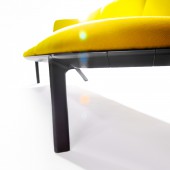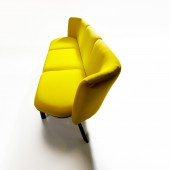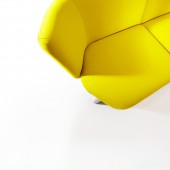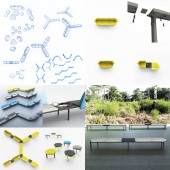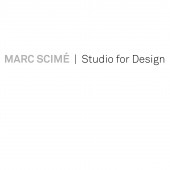Bend Modular Seating System Modular Seating System by Marc Scimé |
Home > Winners > #44561 |
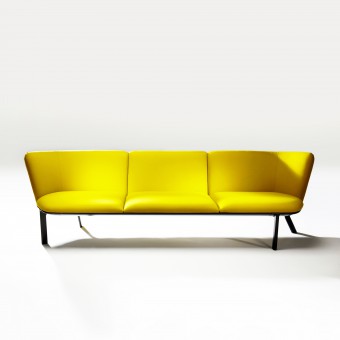 |
|
||||
| DESIGN DETAILS | |||||
| DESIGN NAME: Bend Modular Seating System PRIMARY FUNCTION: Modular Seating System INSPIRATION: Today old boundaries are blurring. Fewer professionals have their own assigned office space and how we work is changing, too. Work can literally happen anywhere, anytime. Leisure and activity, antonyms by classic definition, have become less mutually exclusive. Modern interiors are commonly open environments spatially delineated by furniture. Biophilic desires correlate with more types of architectural environments that seamlessly integrate the outdoors. UNIQUE PROPERTIES / PROJECT DESCRIPTION: Bend is a modular seating system with softened angular shapes that completes Bend and Transition, a scalable and versatile seating and table ecosystem for domestic and public gathering areas. Beyond a typical furniture collection, Bend & Transition offers flexibility to match lifestyles in the digital age—anywhere, anytime, indoors, outdoors and somewhere in between. The Bend sofa prototype (pictured) is one example from a vast range of potential made-to-order seating types and solutions the modular system can offer for working, relaxation, waiting and socializing. OPERATION / FLOW / INTERACTION: Bend modular components can be assembled to create small stools, tete-a-tete sofas, ganged seating islands for a wide range of public areas, such as airport lounges, or classic benches, perhaps for a museum gallery or a garden. Bend seating can be composed in sympathetic acute and obtuse angular relationships to better delineate a variety of unique spaces or create individual personal zones or clustered meeting points. Seat positions can be facing or semi-facing for optimized degrees of social interaction between people or engaging relationships to activities, presentations or views. PROJECT DURATION AND LOCATION: The project started September 2014 in Pasadena, California, USA and finished in April 2015. Bend was exhibited at Art Center College of Design in Pasadena as part of the spring term graduate show. FITS BEST INTO CATEGORY: Furniture Design |
PRODUCTION / REALIZATION TECHNOLOGY: Prototyping of Bend utilized 3D CAD and 3D printing along with industrial equipment and methods. For industrial production, Bend’s main modular aluminum components would be made using extrusion and die-cast processes then treated and powder-coated for outdoor use. Bend seating is upholstered with a state-of-the-art textile made of a very durable high-tech polypropylene fiber with a natural feel, with strong all-around performance and usability suitable for residential, contract, indoor and out environments. SPECIFICATIONS / TECHNICAL PROPERTIES: Bend three seat sofa: Width 2600 mm x Depth 800 mm x Height 730 mm. Sh 380 mm TAGS: Bend, Bend & Transition, modular seating system, furniture ecosystem, sofa, outdoor furniture, residential furniture, contract furniture RESEARCH ABSTRACT: The design of Bend culminated from my master's thesis titled Bend and Transition. The thesis writing and pre-design process entailed extensive research, citing nearly 100 sources, delving into aspects of modern history, evolving workplace and lifestyle trends and attitudes pertaining to most basic aspects of modern living, and how these changes are reflected in new architecture and furniture design. CHALLENGE: Eight months of research, writing, design and prototyping to realize and exhibit Bend (and Transition) was a complete challenge. Designing, engineering and prototyping two types of furniture commenced through the final 18 weeks of project while research and writing were ongoing in parallel. This included research into production methods, material sourcing, and project managing the prototype building itself. At the same time, the collaborative and individual task of designing, promoting and building a graduation exhibition proceeded. A consummate level of project management was as a constant requirement to meet the final deadline with a publishable thesis, near-production-read ADDED DATE: 2016-01-24 01:24:55 TEAM MEMBERS (1) : IMAGE CREDITS: All photographic images by Charles Imstepf and Marc Scimé. Renderings and image post-processing by Studio for Design. PATENTS/COPYRIGHTS: © 2015 Marc Scimé | Studio for Design |
||||
| Visit the following page to learn more: http://marcscime.com | |||||
| AWARD DETAILS | |
 |
Bend Modular Seating System Modular Seating System by Marc Scimé is Winner in Furniture Design Category, 2015 - 2016.· Press Members: Login or Register to request an exclusive interview with Marc Scimé. · Click here to register inorder to view the profile and other works by Marc Scimé. |
| SOCIAL |
| + Add to Likes / Favorites | Send to My Email | Comment | Testimonials | View Press-Release | Press Kit |

